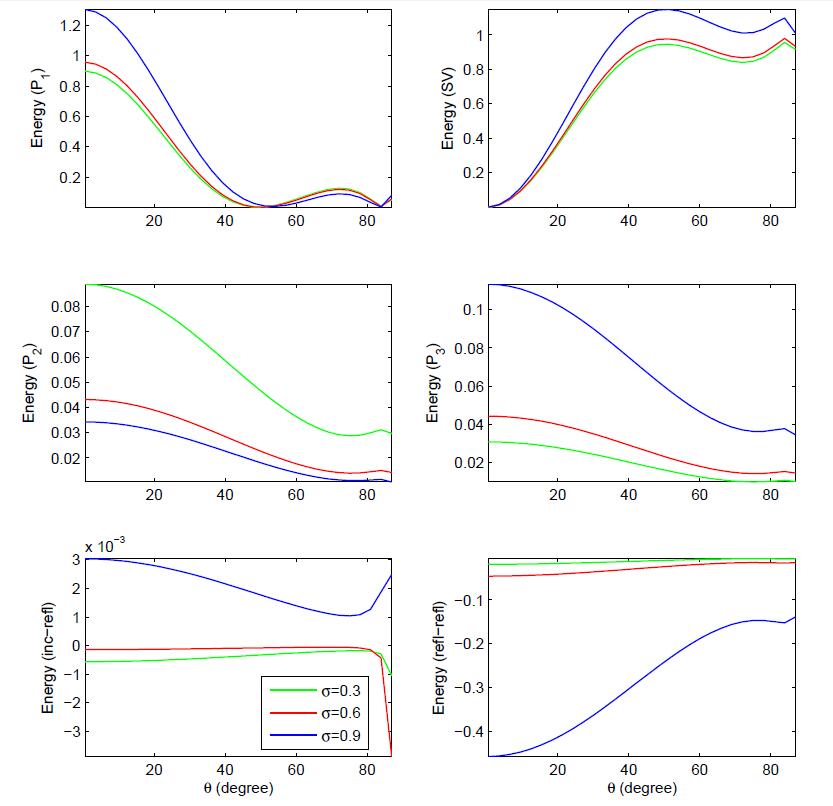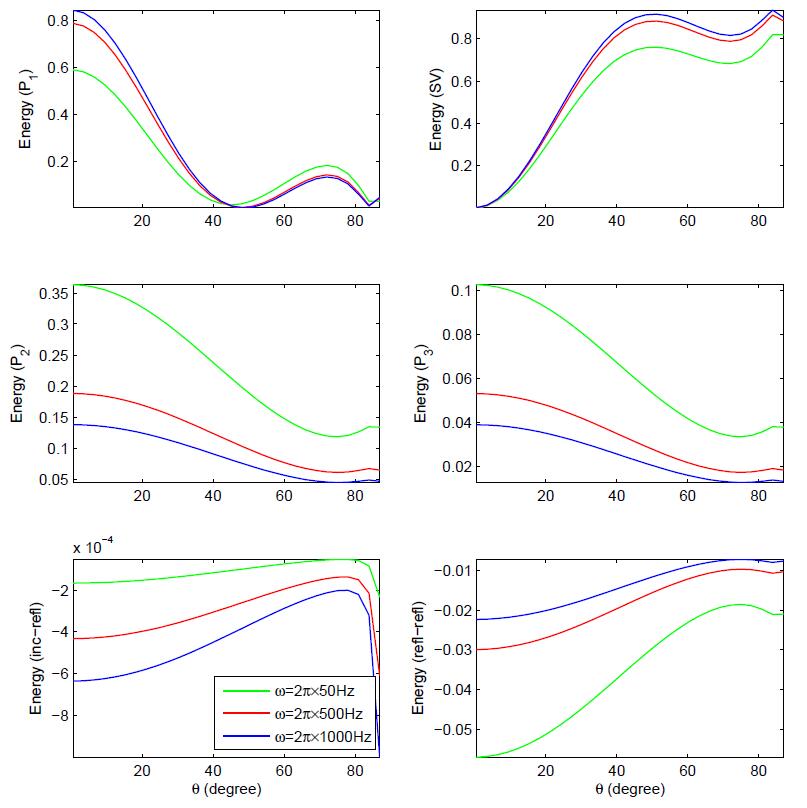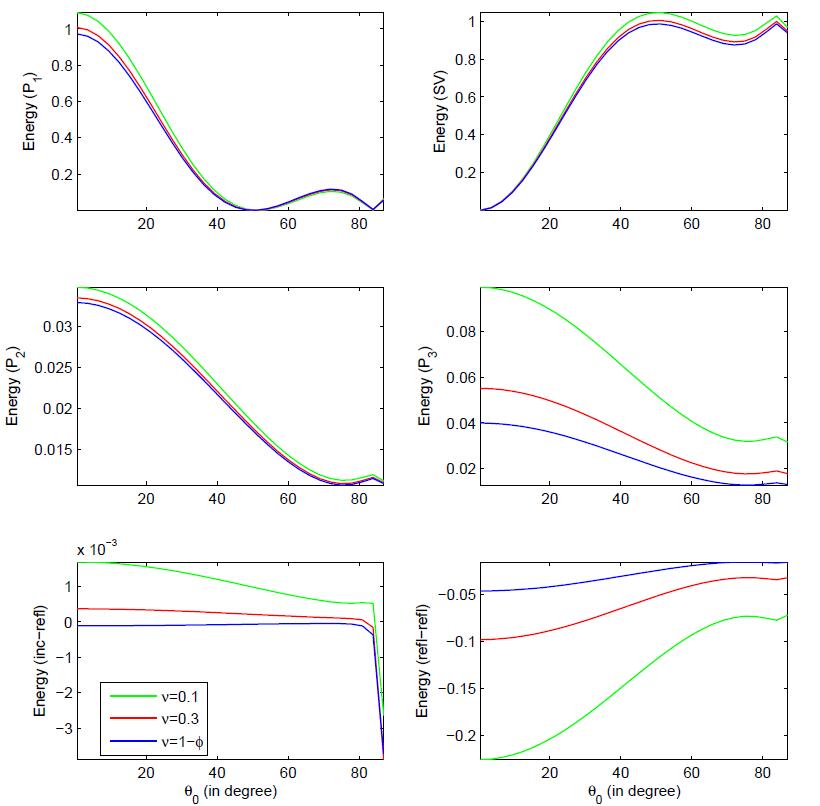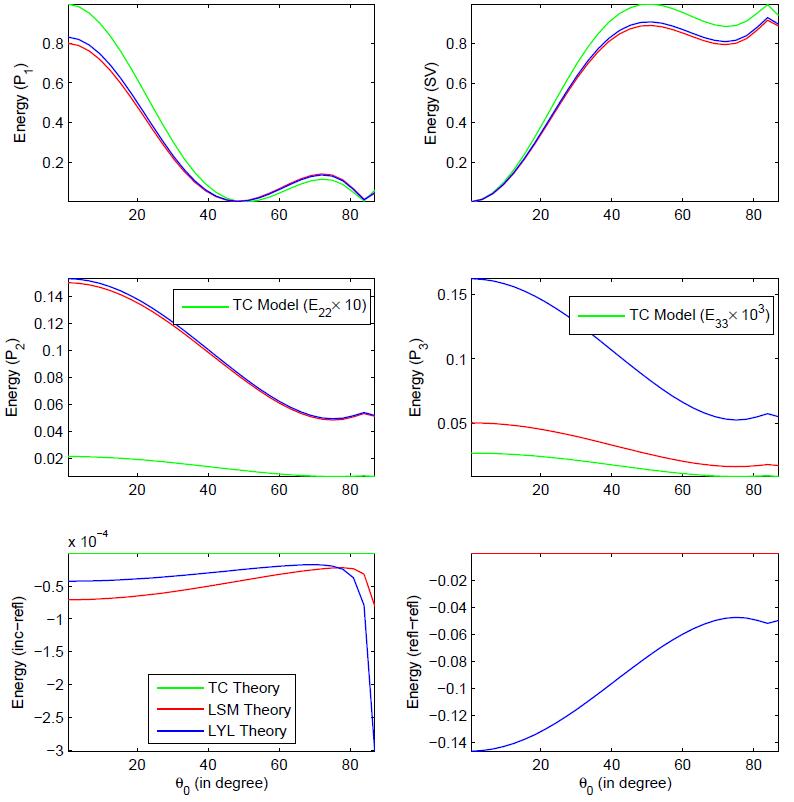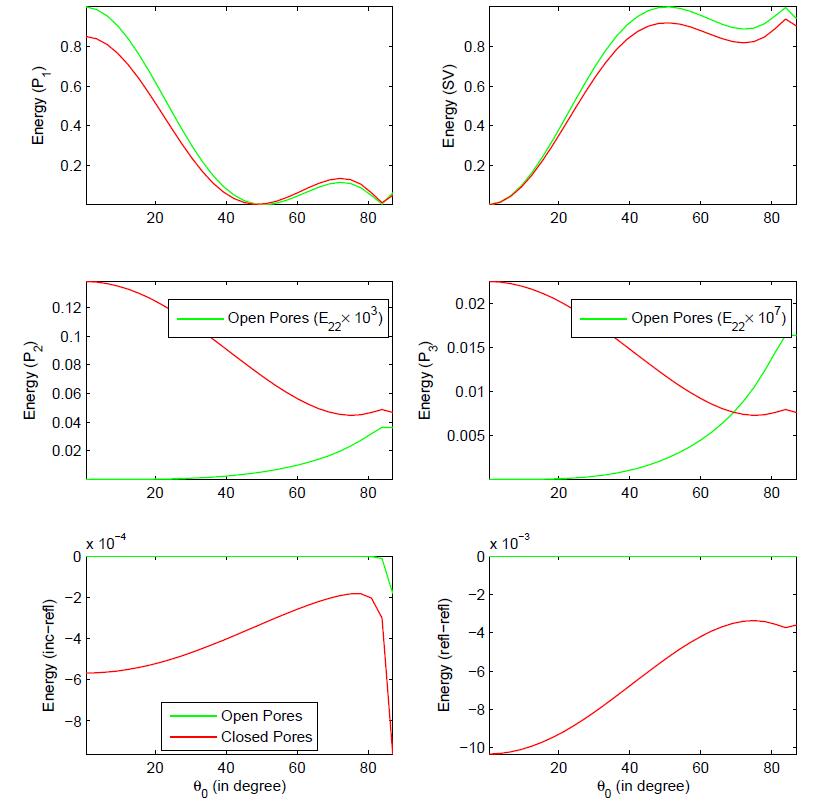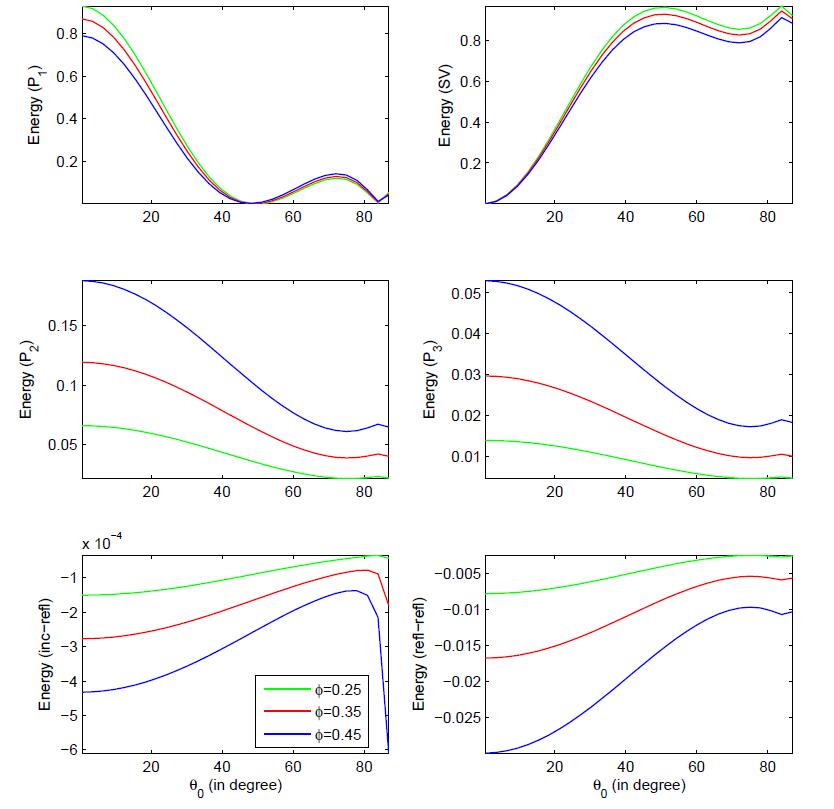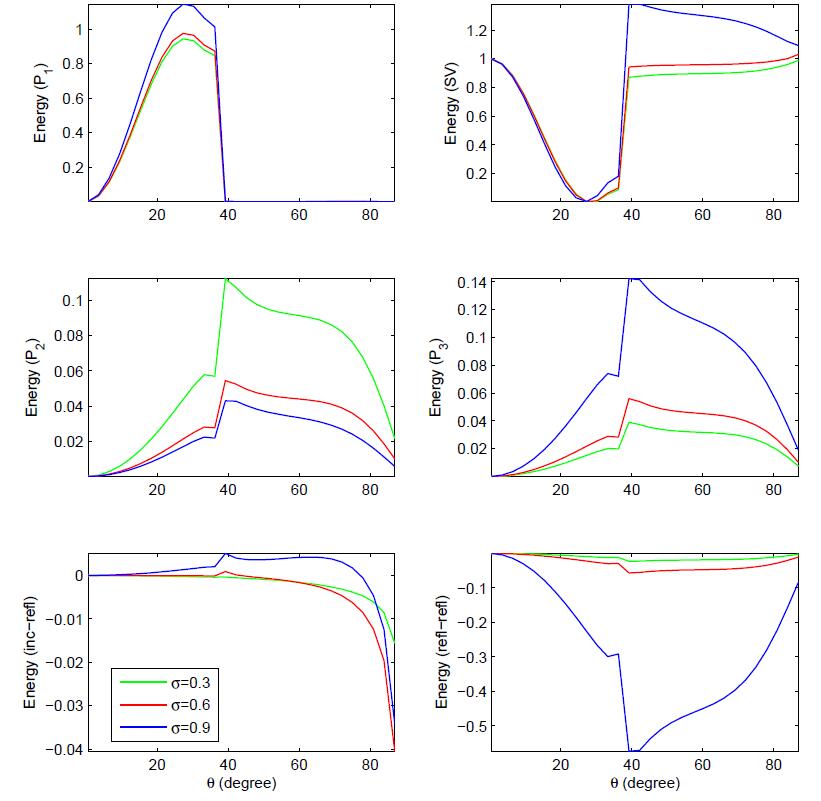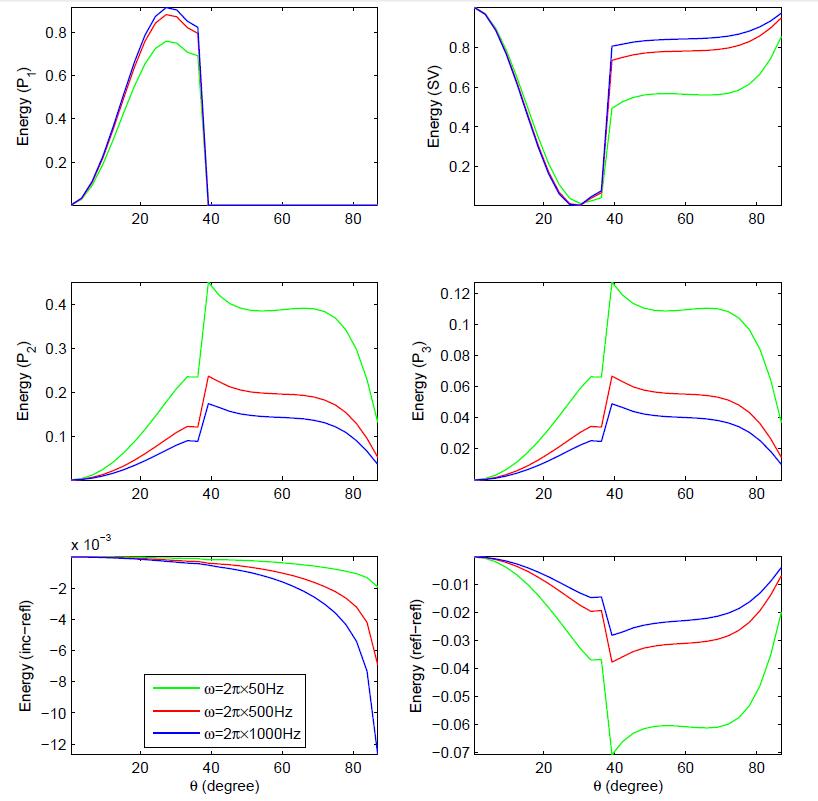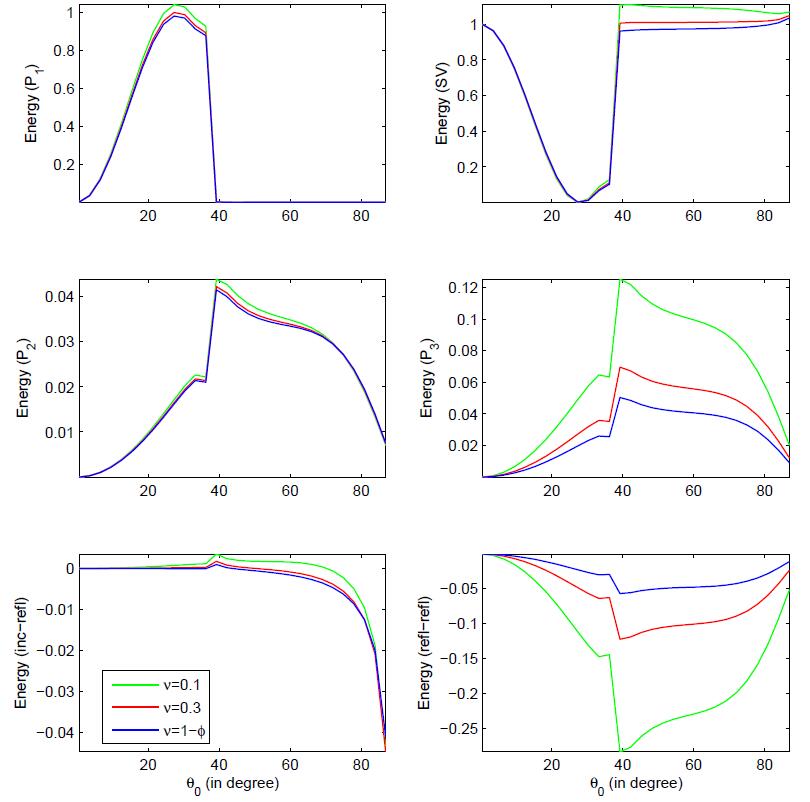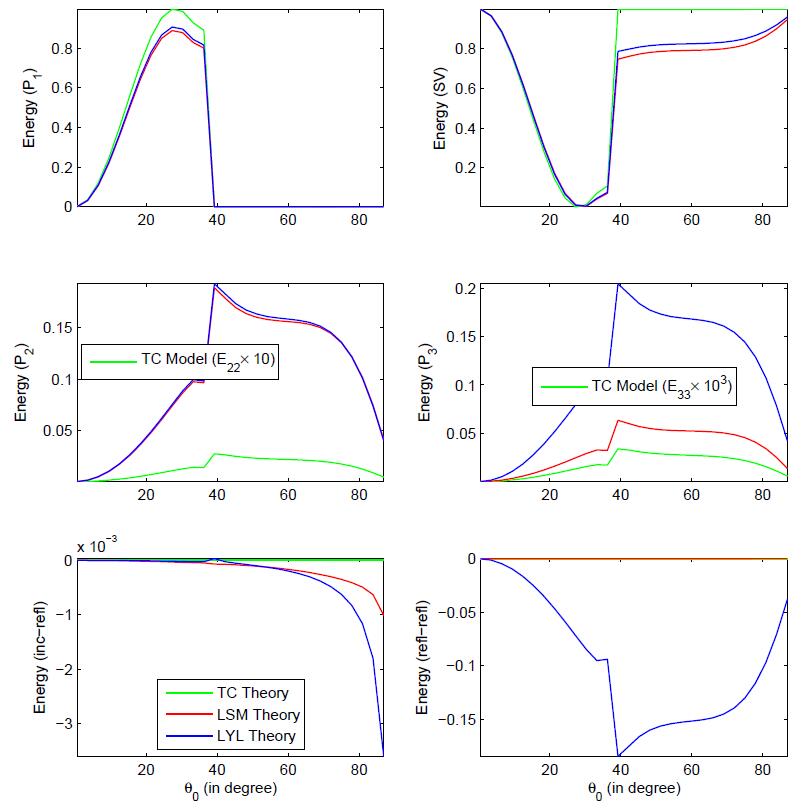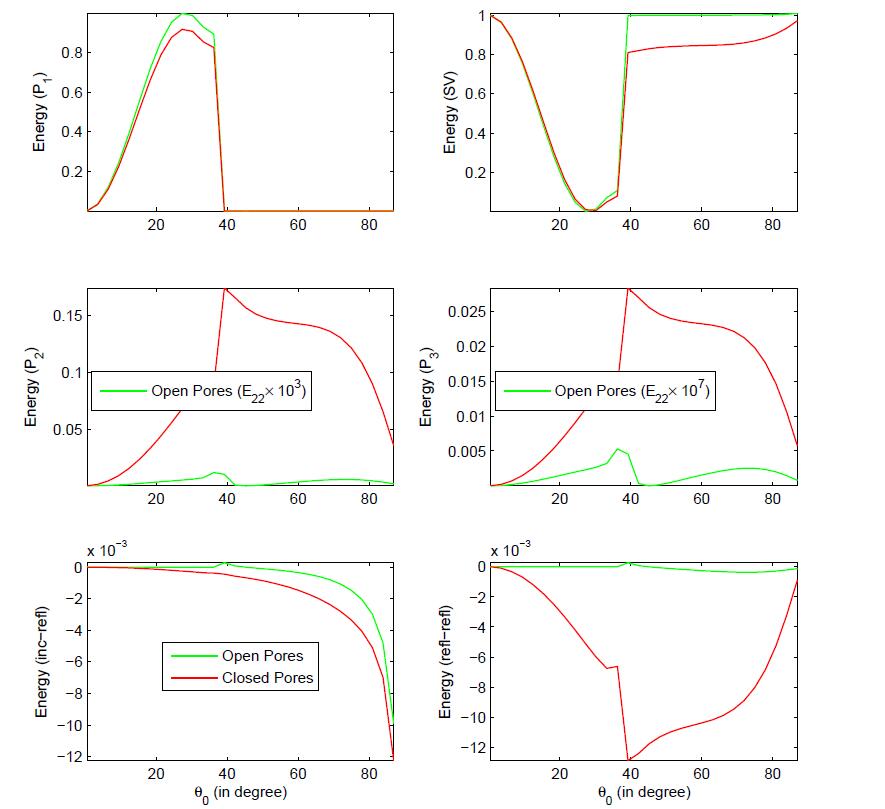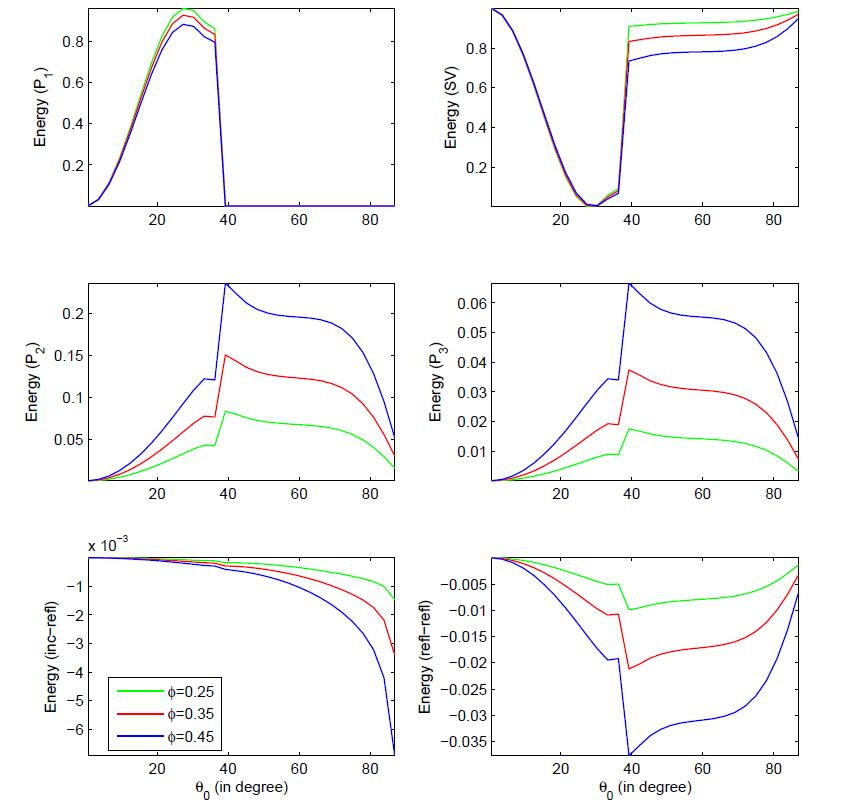1. Introduction
The phenomenon of wave propagation in multiphase poroelasticity theory is appealing extensive attention due to its importance in large number of practical applications in the fields of seismology, geophysics, rock mechanics, soil mechanics and hydrogeology.Biot [1,2,3,4] was the first who introduce the equations of motion for the propagation of elastic waves in a porous solid saturated with single fluid. He found that three (two longitudinal and one shear) waves exist in such a porous medium. In comparison to the porous medium saturated with single fluid, the studies of porous media saturated by multi-fluids are rare. For more realisticinterpretations of elastic waves propagation in porous media demand an accurate and developed mathematical theory.An approach, based on mixture concept, Brutsaert [5] was the first who extended Biot's theory as Mixture theory to includes the effects of two immiscible pore fluids on the behaviour of elastic waves propagation. Mixture theory, generally, developed for two-fluid system, was further improved and generalised by many authors (Brutsaert and Luthin [6]; Bedford and Drumheller [7]; Garg and Nayfeh [8]; Berryman et al. [9]; Santos et al. [10,11]; Corapcioglu and Tuncay [12]; Tuncay and Corapcioglu [13]; Wei and Muraleethara [14,15]; Hanyga [16]; Lu and Hanyga [17]; Lo [18]; Lo et al. [19,20,21]). In multiphase poroelasticity theory, the solution of coupled differential equations of motion showed that four (three longitudinal and one shear) mode of elastic waves exist. Based on the above mentioned models, a study of reflection of plane harmonic waves at the stress-free surface of porous solid have been carried out by some researchers e.g. Sharma and Kumar [22]; Kumar and Kumari [23]; Sharma [24]; Sharma [25]; Tomer and Goyal [26].A latest book by Carcione [27] is referred for relevant references and detailed procedures.In all the above mentioned hydrologic models of subsurface multiphase flow, the effect of viscous resistance due to relative velocity between two adjacent fluids on elastic waves behavior in unsaturated porous media still remains ignored. A recent mathematical model 'based on continuum mixture theory' presented by Lo et al. [28] incorporated the viscous cross-coupling between two immiscible pore fluids. Thus, all the above mentioned models can be derived as the special case of this model. Further, in case of single fluid in medium, this model reduced to Biot [1,2] theory. To account the viscous resistance, they first generalised the equations of motion proposed by Lo et al. [19]. Next, they derived the dispersion relations, which physically shows the existence of four (three longitudinal and one shear) waves in such a medium. At different frequency and water saturation level, the essence of viscous cross coupling on the phase speed and attenuation coefficient of these four elastic waves is analysed for Columbia fine sandy loam containing an gas-water mixture.Keeping the importance of viscous cross-coupling in mind, in this work, we have extended the work of Lo et al. [28]. Present study considers the reflection of inhomogeneous waves at the stress-free plane surface. The methodology is analogous to that presented in Sharma [28]. Firstly, the mathematical model developed by Lo et al. [28] is solved for the propagation of three compressional waves and lone transverse wave after that definition and suitable boundary conditions for the problem are described. By using the appropriate boundary conditions, the closed-form analytical expressions for the reflection coefficients are derived at the stress-free surface. The analytical expressions for the energy shares of various reflected inhomogeneous waves are derived by using these reflection coefficients. Further, a numerical example is considered to illustrate the influences of viscous cross-coupling, porosity, saturation of gas, pore-characteristics and wave frequency on the energy flux characteristics of seismic waves respectively. Specifically, the Lo-Yeh-Lee theory (LYLT) [28] considering viscous cross-coupling between two immiscible fluids in an isotropic porous solid is compared with Tuncay-Corapcioglu theory (TCT) [13], and Lo-Sposito-Majer theory (LSMT) [19] of porous solid containing two immiscible fluids. In mathematical framework, the conservation of incident energy is confirmed by considering an interaction energy between two dissimilar waves. It validates that the numerical calculations are analytically correct. Finally, some conclusions are addressed which may be drawn from the discussions of the numerical results.
2 Basic Equations
The mathematical model proposed by Lo et al. [28] has been considered as reference work, wherein equations of motion for deformable porous media containing two immiscible fluids (say, a gas and a water) incorporating the viscous cross-coupling due to relative velocity between two adjacent fluids are derived. The equations of motion, in the absence of body force, are given by
|
⟨τs⟩ij,j=ρsαs..ui+A11(..vi−..ui)+A12(..wi−..ui)+A21(..vi−..ui)+A22(..wi−..ui)+R11(.vi−.ui)+R12(.wi−.ui)+R21(.vi−.ui)+R22(.wi−.ui),⟨τ1⟩ij,j=ρ1α1..vi−A11(..vi−..ui)−A12(..wi−..ui)−R11(.vi−.ui)−R12(.wi−.ui),⟨τ2⟩ij,j=ρ2α2..wi−A21(..vi−..ui)−A22(..wi−..ui)−R21(.vi−.ui)−R22(.wi−.ui),
|
(1)
|
where ui, vi and wi represent the solid, gas and water particles displacement components respectively.The indices s, 1 and 2 represent the three phases of composite medium such as solid, gas and water, respectively. Else, the variable indices in the tensors can take the values 1, 2, 3. The partial time derivative is represented by a dot over variable.The τ's are used to define stresses, ρ's arematerial densities and α's are volume fractions of thedifferent phases. Coefficients A11 and A22 represent theinertial coupling of two fluid phases with solid.A12 (=A21) identifies inertial coupling between twofluids. Coefficients R11 and R22 define the viscouscoupling of two fluid phases with solid particles whereas R12and R21 represents the viscous cross coupling between twofluids.
The stress-strain relations for the composite medium are given by
|
⟨τs⟩ij=((a11−23G)uk,k+a12vk,k+a13wk,k)δij+G(ui,j+uj,i),⟨τ1⟩ij=(a12uk,k+a22vk,k+a23wk,k)δij,⟨τ2⟩ij=(a13uk,k+a23vk,k+a33wk,k)δij,
|
(2)
|
where δij is Kronecker symbol. G is the shear modulus of
the porous frame and the elastic coefficients aij (=aji)
of the porous aggregate are given in the Appendix.
Equations of motion, in terms of the displacement components are written as follows.
|
(a11+13G)uj,ij+a12vj,ij+a13wj,ij+Gui,jj=(ρsαs−A11−A12−A21−A22)..ui+(A11+A12)..vi+(A12+A22)..wi−(R11+R12+R21+R22).ui+(R11+R21).vi+(R22+R12).wia12uj,ij+a22vj,ij+a23wj,ij=(A11+A12)..ui+(ρ1α1−A11)..vi−A12..wi+(R11+R12).ui−R11.vi−R12.wi,a13uj,ij+a23vj,ij+a33wj,ij=(A21+A22)..ui−A21..vi+(ρ2α2−A22)..wi+(R21+R22).ui−R21.vi−R22.wi.
|
(3)
|
3 Harmonic Plane Waves
The displacement components to study the propagation of plane harmonic wave in the medium are given by
|
(ui,vi,wi)=(Ai,Bi,Ci)exp{iω(sjxj−t)}, (i=1,2,3),
|
(4)
|
where the vectors (A1,A2,A3), (B1,B2,B3)
and (C1,C2,C3) are defined as the polarizations of the solid, gas and water particles in the composite medium respectively. The slowness vector (s1,s2,s3)=n/V represents the propagation/attenuation of a wave through a
unit vector n=(n1,n2,n3) and the velocity V. By substituting (3.1) in (2.3), we get nine homogeneous equations, given by
|
[(a11+13G)ninj+(G−ρssV2)δij]Aj+[a12ninj−ρs1V2δij]Bj+[a13ninj−ρs2V2δij]Cj=0,
|
(5)
|
|
[a12ninj−ρ1sV2δij]Aj+[a22ninj−ρ11V2δij]Bj+[a23ninj−ρ12V2δij]Cj=0,
|
(6)
|
|
[a13ninj−ρ2sV2δij]Aj+[a23ninj−ρ21V2δij]Bj+[a33ninj−ρ22V2δij]Cj=0,
|
(7)
|
where
ρss=ρsαs−A11−A12−A21−A22−ιω(R11+R12+R21+R22),
ρs1=A11+A12+ιω(R11+R21),
ρs2=A12+A22+ιω(R12+R22),
ρ1s=A11+A12+ιω(R11+R12),
ρ11=ρ1α1−A11−ιωR11,
ρ12=−A12−ιωR12,
ρ2s=A21+A22+ιω(R21+R22),
ρ21=−A21−ιωR21,
ρ22=ρ2α2−A22−ιωR22.
The equations (3.4) and (3.5) are solved into two relations, given by
|
Bi=ΓijAj,Γ=b0a0(I−nTn)+b0V4+b1V2+b2a0V4+a1V2+a2nTn,
|
(8)
|
|
Ci=ΔijAj,Δ=c0a0(I−nTn)+c0V4+c1V2+c2a0V4+a1V2+a2nTn,
|
(9)
|
where, I is the identity matrix and nT identify the transpose of the row-matrix n=(n1, n2, n3).
The above relations interrelate the polarisations (displacements) of solid particles with gas and water particles in the porous aggregate. The polarisation vector A defines the polarisation of solid particles in the aggregate. Polarisations of the gas and water particles are calculated from the relations (3.5) and (3.6), respectively.
where, a0=ρ11ρ22−ρ12ρ21, a1=a23ρ12+a23ρ21−a22ρ22−a33ρ11, a2=a22a33−a223,
b0=ρ12ρ2s−ρ1sρ22, b1=a12ρ22+a33ρ1s−a13ρ12−a23ρ2s, b2=a13a23−a12a33,
c0=ρ1sρ21−ρ2sρ11, c1=a13ρ11+a22ρ2s−a12ρ21−a23ρ1s, c2=a12a23−a13a22.
Substituting (3.5) and (3.6) in (3.3), we get the following relations
|
DijAj=0,D=a3(I−nTn)+b3nTn,
|
(10)
|
a3=G−(ρss+b0a0ρs1+c0a0ρs2)V2,
b3=a11+43G−ρssV2+(a12−ρs1V2)(b0V4+b1V2+b2a0V4+a1V2+a2)+(a13−ρs2V2)(c0V4+c1V2+c2a0V4+a1V2+a2).
The system of equation (3.7) represent the Christoffel equations. Non-trivial solution of this system is ensured by a cubic equation (in V2)
|
d3V6+d2V4+d1V2+d0=0,
|
(11)
|
where,
|
(d3d2d1d0)=[a0b0c0a1b1c1a2b2c2000](ρssρs1ρs2)−[000a0b0c0a1b1c1a2b2c2](a11+43Ga12a13),
|
and a linear equation (in V2), given by
|
G−(ρss+b0a0ρs1+c0a0ρs2)V2=0.
|
(12)
|
The three roots of the cubic equation (3.8) explains the
existence of three longitudinal waves (i.e., polarization vector is parallel to propagation vector) propagating with velocities (Vj, j=1,2,3). For convenience, the three longitudinal waves identified with velocities V1, V2 and V3 are termed as P1,P2 and P3 wave, respectively.
In an analogs manner, the single root of equation (3.9), explains the
existence of lone transverse wave (i.e., polarization vector is normal to propagation vector) propagating with velocity V4, given by the relation V24=G/(ρss+b0a0ρs1+c0a0ρs2). This lone transverse wave is identified as SV wave.
4 Reflection at Plane Boundary
In this study our goal is to analyze the effects of viscous cross-coupling, porosity, saturation of gas, pore-characteristics and wave frequency on the energy shares of various reflected inhomogeneous waves at the stress free surface of partially porous solid.
4.1 Definition of the Problem
Consider a rectangular coordinate system (x,y,z), in which
half-space z> 0 is occupied by a saturated porous solid with
its depth increasing along the z-direction as shown in geometrical Fig.1. The plane z=0 is considered as stress free surface of this medium.
Following Borcherdt [29], in terms of angle of propagation (θ0), angle of attenuation
(γ0), propagation vector (P) and attenuation
vector (A), the horizontal slowness is defined as
|
s=|P|sinθ0−ι|A|sin(θ0−γ0),
|
(13)
|
where, for incident wave of velocity V0, we have
|
|P|2=12[Re(ω2V20)+√(Re(ω2V20))2+(Im(ω2V20))2/cos2γ0],
|
(14)
|
|
|A|2=12[−Re(ω2V20)+√(Re(ω2V20))2+(Im(ω2V20))2/cos2γ0].
|
(15)
|
Due to the dissipative nature of porous medium, the incident wave at the boundary z=0 is specified through its propagation direction
(θ0) and attenuation direction (γ0). The vector (s,0,q0) specify the slowness vector of incident wave, where q0(=±√V20−s2) is the vertical slowness of incident wave. To ensure the propagation of incident wave towards the boundary (i.e., negative z-direction), we must have ℜ(q0)<0.
According to Snell's law the horizontal slowness(s) of both incident and reflected waves will be remains same. Then, the vector (s,0,qk) specify the
slowness vector for reflected waves, where qk=±√V2k−s2,(k=1,2,3). To assure the decay of reflected waves moving away from boundary (i.e., positive z-direction), we must have ℑ(qk)>0.
Then, the total displacement of material particles of medium is the sum of displacements associated with incident wave and three reflected waves. Hence, for two dimensional motion in xz-plane, the general displacement of material particles is expressed as
|
uj=[A(0)jexp(−ιωq0z)+4∑k=1fkA(k)jexp{ιω(sx+qkz−t)}],vj=[B(0)jexp(−ιωq0z)+4∑k=1fkB(k)jexp{ιω(sx+qkz−t)}],wj=[C(0)jexp(−ιωq0z)+4∑k=1fkC(k)jexp{ιω(sx+qkz−t)}],(j=x,z),
|
(16)
|
where, fk are the excitation factors for reflected waves
relative to incident wave. The index ‘0' represent the incident
wave. The index ‘k'(=1,2,3) represent, respectively, the
reflected (P1,P2,P3,SV) waves. To define polarization of a
longitudinal and transverse wave, the required unit vector n is obtained as n=(s,0,qk)Vk.
4.2 Boundary Conditions
In the present geometry, boundary conditions for the particle motion are considered at the stress free plane surface z=0. In this problem, we consider two kinds of boundary conditions at the plane z=0, one is impermeable boundary (sealed pores) and other is permeable boundary (fully-opened pores). In case of impermeable boundary (sealed pores), no discharge of interstitial fluid is allowed at the surface with the passage of waves. While in case of permeable boundary (fully-opened pores), the fluid pressure should be vanish at the plane z=0. Hence, the suitable boundary conditions to be satisfied at the plane z=0 are given by
|
i) ⟨τs⟩zz=0,ii) ⟨τs⟩zx=0,iii) ζT0vz−(1−ζ)⟨τ1⟩zz=0,iv) ζT0wz−(1−ζ)⟨τ2⟩zz=0,
|
(17)
|
where, T0 is a scaling parameter that ensures dimensional homogeneity. The parameter ζ=1 define the impermeable boundary (sealed surface-pores) and
ζ=0 define the permeable boundary (fully-opened surface-pores).
4.3 Reflection Coefficients
We obtain a system of four simultaneous non-homogeneous linear equations after solving the four boundary conditions (4.5) using displacements defined in equation (4.4). The system of four equations, are given by
|
4∑k=1blkfk=−bl0,(l=1,2,3,4).
|
(18)
|
For (k=1,2,3,4), we have
b1k=(a11−2G/3)[sA(k)x+qkA(k)z]+a12[sB(k)x+qkB(k)z]+a13[sC(k)x+qkC(k)z]+2GqkA(k)z,
b2k=G[qkA(k)x+sA(k)z],b3k=ζT0B(k)z−(1−ζ)Yk,b4k=ζT0C(k)z−(1−ζ)Zk,
where, Yk=a12[sA(k)x+qkA(k)z]+a22[sB(k)x+qkB(k)z]+a23[sC(k)x+qkCkz]
and Zk=a13[sA(k)x+qkA(k)z]+a23[sB(k)x+qkB(k)z]+a33[sCkx+qkC(k)z].
System (4.6) is solved for four unknowns fk(k=1,2,3,4) by using Gauss elimination method. These unknown
may be treated as reflection coefficients.
4.4 Energy Partition
In this article, our goal is to study the partition of incident wave energy into distinct reflected waves. The energy communicated per unit area at the plane z=0 is the scalar product of surface traction and particle velocity (Achenbach [30]). Due to dissipative nature of porous medium, the concept of interaction energy (Borcherdt [29]; Krebes [31]) or the interference energy (Ainslie and Burns [32]) between two dissimilar waves is also involved. Therefore, total energy flux is the sum of energy flux carried out by reflected waves and interaction energy between two dissimilar waves. In the present geometry, medium supports the propagation of four (one incident and three reflected) waves.
Hence, to described the distribution of incident energy at the surface z=0, an energy matrix is defined as
|
Elk=ℜ(Plkfl¯fk)/ℜ(P55),(l,k=1,2,3,4,5);
|
(19)
|
where f5=1. A bar over a complex quantity denotes conjugate. The elements Plk in equation (4.7) are given by
|
Plk=[(a11−2G/3)[sA(l)x+qlA(l)z]+a12[sB(l)x+qlB(l)z]+a13[sC(l)x+qlC(l)z]+2GqlA(l)z]ˉA(k)z+G[sA(l)z+qlA(l)x]ˉA(k)x+YlˉB(k)z+ZlˉC(k)z.
|
(20)
|
The energy matrix Eij, (i,j=1,2,3,4), calculates the energy shares of three reflected (P1, P2,P3, SV) waves in porous medium. The
diagonal entries E11, E22, E33 and E44 identify the energy shares of reflected P1, P2, P3 and SV waves,
respectively. The interaction energy due to the interference of each reflected wave with incident wave is given by
EIR=∑4i=1(E5i+Ei5). The interaction energy due to the interference between each pair of reflected waves is given by ERR=∑4i=1(∑4j=1Eij−Eii). Then,
conservation of energy at the stress free surface is assured through the relation ∑5l=1∑5k=1Elk=0.
5 Numerical Results and Discussion
5.1 Numerical Example
The main purpose of this study is to analyze the effects of viscous cross-coupling, porosity, saturation of gas, pore-characteristics and wave frequency on the energy shares of various reflected inhomogeneous waves at the stress free surface of partially porous solid. Numerical study is carried out by Matlab. Hence, a numerical example is considered. To choose the numerical values of various parameters, we consider a reservoir rock (sandstone) saturated with water and CO2. The values of relevant material and fitting parameters (Garg and Nayfeh [8]; Lo et al. [19]) are given in Table 1.
Table 1. Material and fitting parameters of a reservoir rock (sandstone) saturated with water and CO2.
| Parameter | Symbol | Value |
| Bulk modulus of gas | K1 | 3.7MPa |
| Bulk modulus of solid | Ks | 35GPa |
| Bulk modulus of the porous framework | Kb | 12GPa |
| Shear modulus of the porous framework | G | 9GPa |
| Bulk modulus of water | K2 | 2.25GPa |
| Fitting parameter | n | 2.145 |
| Fitting parameter | η | 0.5 |
| Fitting parameter | χ | 1m−1 |
| Material density of gas | ρ1 | 103Kg/m3 |
| Material density of solid | ρs | 2650Kg/m3 |
| Material density of water | ρ2 | 990Kg/m3 |
| Intrinsic permeability of porous framework | ks | 5.3×10−13m2 |
| Viscosity of gas | μ1 | 18×10−6Ns/m2 |
| Viscosity of water | μ2 | 0.001Ns/m2 |
5.2 Discussion of Numerical Results
The partitions of incident energy among various reflected waves and interaction energy between two distinct waves is defined by the energy matrix E in the section 4.4. The variations of these energy shares with incident direction (θ0∈(0, 900)) are presented in figures 2 to 7 (for incident P1 wave) and in figures 8 to 13 (for incident
SV wave). The detailed discussion on figures is as follows.
5.2.1 For the Incidence of P1 Wave
Fig.2 presents the essence of incident direction (θ0) and gas saturation (σ) on the various energy shares and interaction energies. A significant effect of gas saturation is clearly seen on all the reflected waves and interaction energy between two dissimilar waves. For the incidence below 550, P1 wave strengthens with the increase of gas shares in pores. However, beyond 550 it weakens slightly with this change. The SV wave strengthens with the increase of gas share in pores, particularly beyond 250. Further, it is clear that P2(P3) wave weakens (strengthens) with the increase of gas share in pores. Near normal (grazing) incidence domination shift in favour of P1(SV) wave. In the mathematical framework, energy conservation at the boundary is confirmed by considering the interference energy between two dissimilar waves.
Fig.3 displays the essence of frequency on the various energy shares. The P1 wave strengthens with the increase of frequency and beyond incidence 500, it weakens with the increase of frequency. For incidence beyond 200, SV wave strengthens with the increase of frequency. Further, it is noted that qualitative behaviour of P2 and P3 waves are alike. All the waves are dispersive in nature.
Fig.4 shows the effect of viscous cross-coupling parameter (ν) on the various energy shares with the incident direction θ0. The negligible influence of viscous cross-coupling is visible on the P1, P2 and SV waves. Whereas, a significant effect of viscous
cross-coupling is noticed on the propagation of P3 wave and
interaction energies. All the waves are weakens with the increase of viscous cross-coupling.
Fig.5 displays the variations of various energy shares with incident direction (θ0), corresponding to three different theories. Mathematical theory presented by Lo et al. [28]
(LYLT) incorporated the viscous cross-coupling
between two immiscible pore fluids. It is observed that after
neglecting the viscous cross-coupling terms from equations of motion, the
LYLT reduces to LSMT. Further, in the absence of
both inertial coupling and viscous cross-coupling terms, it
reduces to TCT. It is clear that the qualitative behaviour of
all energy shares are alike in all the three different theories.
In case of P3 wave, a significant quantitative difference between
these theories appear. Further, the energy shares of P1 and SV waves are maximum for TCT and minimum for LYLT. While, the energy shares of reflected P2 and P3 waves are maximum for LYLT and minimum for TCT. A weaker quantitative difference in all energy shares is observed corresponding to LYLT and LSMT except the energy share of P3 wave.
The variations in energy partition with incident direction (θ0), corresponding to open and sealed surface-pores is depicted in Fig.6. A permeable boundary surface reflect a stronger P1 wave, below the incidence 500. The reflected SV wave at permeable boundary (fully-opened surface-pores) is almost dominated on impermeable
boundary (sealed surface-pores), for θ0∈(0, 900). Further, a
large quantitative difference is noticed in the reflected P2 and P3 waves at permeable and impermeable boundary. At impermeable (permeable) boundary, the P2 and P3 waves are significant (insignificant).
The effect of porosity on the various energy partition is shown in
Fig.7. The effect of porosity on P1 wave is quite significant
below the incidence 550. Whereas, for the incidence beyond 300, a little bit essence of porosity is observed on the SV wave. Further,
reflected P2 and P3 waves becomes stronger with the increase in porosity.
5.2.2 For the Incidence of SV Wave
Fig.8 displays the variations of energy shares with incident direction (θ0) and gas saturation (σ). Alike the incident P1 wave in Fig.2, a significant essence of gas saturation is clearly visible on all the energy shares. The critical angles are found for P1 and SV waves around 400 and 280, respectively. Variational pattern of P1 wave shows a reverse behaviour to that of the SV wave. For the incidence below 400, P1 wave strengthens with the increase of gas saturation. Whereas, for the incidence beyond 400, SV wave strengthens with the increase of gas shares in pores. Moreover, P2(P3) wave weakens (strengthens) with the increase of gas shares in pores. For near normal incidence, it is observed only SV wave survive quantitatively.
Fig.9 displays the effect of wave frequency (ω) on the various energy shares. With the increase of wave frequency, P1 and SV waves becomes quite stronger but P2 and P3 waves becomes weaker with this change. Further, variational pattern of P2 and P3 waves are almost alike.
Fig.10 shows the essence of viscous cross-coupling parameter (ν) on the various energy shares. Almost all the energy shares decreases with the increase of viscous cross-coupling. The effect of viscous cross-coupling on P1,P2 and SV waves is little bit significant.
The variations in energy partition with incident direction (θ0), corresponding to three different theories are shown in Fig.11. In case of P3 wave, a significant difference is observed between these theories. Whereas, in case of P1,P2 and SV waves, a insignificant difference is observed between LYLT and LSMT.
The variations in energy partition with incident direction (θ0), corresponding to open and sealed surface-pores is depicted in Fig.12. The observation found corresponding to these surface-pores characteristics are nearly same as the case of incident P1 wave in Fig.6.
The effect of porosity on the various energy shares with incident direction θ0 is shown in Fig.13. It is clearly visible that for incidence below 400, P1 wave strengthens with the increase of porosity and beyond 400, SV wave strengthens with the increase of porosity. Further, P1 and P2 waves also strengthens with the increase of porosity.
6 Conclusions
In this article, reflection of inhomogeneous waves at the stress-free plane surface of partially saturated porous solid is investigated. Porous medium is considered dissipative due to the involvement of viscosity in pores fluid. Four waves (three longitudinal and one shear) are found to be reflected, as a result of incident wave. All the reflected waves are inhomogeneous in nature (i.e., different direction of propagation and attenuation). Appropriate boundary conditions are used for opened surface-pores (permeable boundary) and fully closed surface-pores (impermeable boundary). For both incident P1 and SV waves, energy flux characteristics of seismic waves are studied analytically and numerically for a particular model. The closed-form analytical expressions for the reflection coefficients of various reflected waves are computed analytically at the stress-free plane surface. Further, these reflection coefficients are used to calculate the energy shares of various reflected waves. Conservation of the incident energy at the plane interface is confirmed by considering the interaction energy between two dissimilar waves. Finally, for particular model, effect of hydrological properties (like, viscous cross-coupling, porosity, saturation of gas, pore-characteristics) and wave frequency has been studied on energy flux characteristics of seismic waves. The energy flux characteristics correspond to the TCT, LSMT and LYLT are also presented in this study. Finally, some conclusions are addressed which
may be drawn from the discussions of the numerical results.
• At the normal incidence of SV wave, only SV wave is survive quantitatively among all the reflected waves. While at the normal incidence of P1 wave, only SV wave is not survive quantitatively.
• The P2 wave weakens but P3 wave strengthens, with the increase of gas saturation.
• For both incident P1 and SV waves, P2 and P3 waves are found to be strengthens (weakens), with the increase of porosity (frequency).
• The P2 and P3 waves are strengthens (weakens) when the pores at the reflecting boundary are fully-closed (fully-opened). Whereas, P1 and SV waves are weakens (strengthens) when the pores at the reflecting boundary are fully-closed (fully-opened).
• The basic difference between TCT, LSMT and LYLT is mainly observed in the behaviour of P2 and P3 waves. Due to the involvement of viscous cross-coupling between two fluids in the equations of motion, energy shares of P2 and P3 waves are found to be strengthen.
• The energy shares of P3 wave is found to be greatly influenced due to the involvement of viscous cross-coupling terms in the equations of motion. Hence, this fact shows that the present study is in good agreement with the Lo et al. [28] study. This is due to the fact that Lo et al. [28] study shows that the presence of viscous cross-coupling between two fluids, significantly influenced the phase speed of P3 wave.
• All the waves are dispersive (i.e., frequency dependent) in nature.
• In mathematical framework, the conservation of the incident energy is confirmed by considering the interaction energy between two dissimilar waves due to the dissipative nature of the considered medium. This validates that the numerical calculations are analytically correct.
Finally, for both incident P1 or SV wave, it is found that the energy flux characteristics of seismic waves depend on several factors, such as wave frequency, gas saturation, porosity, pore-characteristics and viscous-cross coupling between two fluids. Therefore, the study of energy flux characteristics can yield to useful information about the rock properties.
7 Apendix
Following Lo et al. [21], the elasticity coefficient aij in terms of directly measurable parameters are given as
a11=K0[α0N1{K1K2+K1N2σ+K2N2(1−σ)}+KbK0(1−α0){K1(1−σ)+K2σ+N2}]/N3,
a12=[K0K1(1−α0)σN1(K2+N2)]/N3,
a13=[K0K2(1−α0)(1−σ)N1(K1+N2)]/N3,
a22=[K1(1−α0)σ{K20(1−α0)(σK2+N2)+K2(1−σ)N1N2}]/N3,
a23=−[K1K2(1−α0)(1−σ)σ{N1N2−(1−α0)K20}]/N3,
a33=[K2(1−α0)(1−σ){K20(1−α0)(K1(1−σ)+N2)+K1σN1N2}]/N3,
dpcdσ=(ρ2g/(n−1)m)[{(1−σ)−(nn−1)−1}(1−nn)(1−σ)−(2n−1n−1)],
N1=K0α0−Kb,N2=dpcdσσ(1−σ),
N3=[N1{K1N2σ+K1K2+K2N2(1−σ)}+K20(1−α0){K1(1−σ)+N2+K2σ}],
where K0, K1, K2 and Kb denote the bulk moduli of three
constituent phases and porous skeleton, respectively.
Viscous cross-coupling coefficients are given by
R11=−λ22α21Δ, R12=λ12α1α2Δ, R21=λ21α1α2Δ, R22=−λ11α22Δ,
λ11=(1+ν12)b∗1,
λ12=(1−ν12)b∗1,
λ21=(1−ν22)b∗2,
λ22=(1+ν22)b∗2,
Δ=λ11λ22−λ12λ21,
χ1=σχ[1−(1−σ)nn−1]2(n−1)n,
χ2=(1−σ)χ[1−{1−(1−σ)nn−1}n−1n]2,
b∗1=χ1/η1,
b∗2=χ2/η2,
where νj signifies the interfacial coupling parameter of fluid phases j (Ayub and Bentsen [33]). For an idealized channel flow,
according to Ayub and Bentsen [33] ν1=ν2=ν=1−ϕ (ϕ being the porosity). η1 and
η2 denote the viscosities of gas and liquid phases,
respectively. The relative permeabilities χ1, χ2 for the
flow of two pore-fluids are defined in comparison to the intrinsic
permeability (χ0) of the composite medium. The capillary
pressure (pc) is due to the interfacial interactions between
the two viscous pore-fluids. It varies with the fraction
(σ) of gas or the fraction of liquid (1−σ) in
twin-fluid mixture filling the pore space. The quantities m,
n and χ are model parameters. These are obtained by fitting
the experimental data on the pc-σ and χj-σ
relations, which are used in defining aij.
According to Lo et al. [19], inertial-coupling coefficients are given by
A11=ρ1α1(1−βs),
A22=ρ2α2(1−βs),
A12=A21=−0.1√α1α2ρ1ρ2β2s,
βs=α02(α0−1).









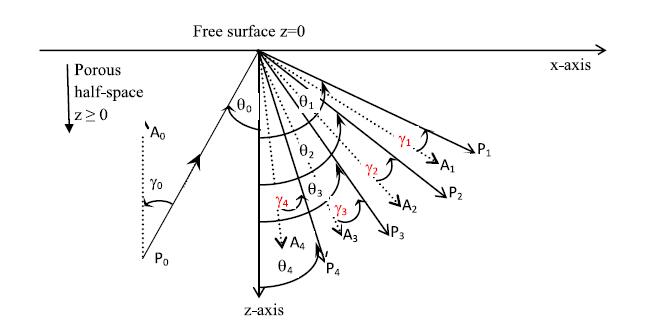
 DownLoad:
DownLoad: 